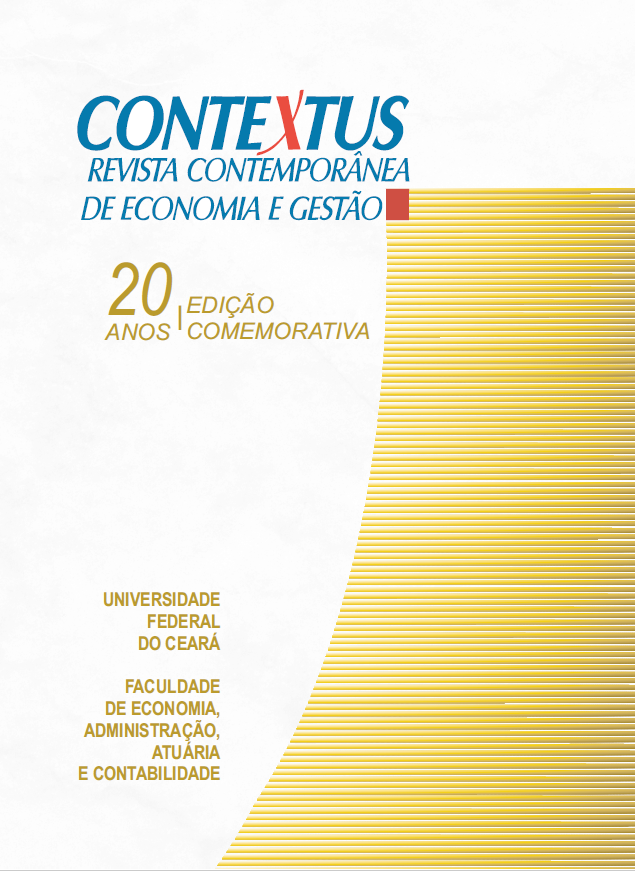Determining factors of university evasion: An analysis with UNISINOS students
DOI:
https://doi.org/10.19094/contextus.2023.88622Keywords:
dropout of university, logit regression, determinant of dropout of university, opportunity cost, university administrationAbstract
This work aims to conduct an analysis of the determinants of university dropout from the University of the Bells River Valley (UNISINOS). The study was conducted from a representative sample of students in UNISINOS, entrants in the period from 2005 to 2008, and evaluated by Logit regression of the relationship between socioeconomic variables and dropout students. It was concluded that some of the variables had increased relative to the avoidance, for example, the variable subjects canceled, wherein a greater number of cancellations resulted in a higher probability of escaping. Like others who had inverse relation to this phenomenon, as the variable subjects taken, in which a greater number of courses taken per semester, reduced the chances of evading student.
References
Almeida, E. P., & Veloso, T. C. M. A. (2002). Evasão nos cursos de graduação da Universidade Federal de Mato Grosso, campus universitário de Cuiabá: Um processo de exclusão. Cuiabá: UFMT.
Baggi, C. A. S., & Lopes, D. A. (2011). Evasão e avaliação institucional no ensino superior: Uma discussão bibliográfica. Avaliação, 16(2), 355-374. https://doi.org/10.1590/S1414-40772011000200007
Bardagi, M., & Hutz, C. S. (2005). Evasão universitária e serviços de apoio ao estudante: Uma breve revisão da literatura brasileira. Psicologia Revista, 14(2), 279-301.
Borges, P. (2012). MEC e universidades estudam planos para combater evasão. Último Segundo/Educação. IG Brasília. http://ultimosegundo.ig.com.br/educacao/mec-e-universidades-estudam-planos-para-combater-evasao/n1597622390779.html
Deke, J. A. (2003). Study of the impact of public school spending on post secondary educational attainment using statewide school district refinancing in Kansas. Economics of Education Review, 22(3), 275-284. https://doi.org/10.1016/S0272-7757(02)00025-0
Dias, E. M. (1997). A dúvida da continuidade dos estudos universitários: uma questão adolescente. Taubaté: Cabral.
Garner, R. (2007). More than 100.000 students drop out of university after first year. http://www.independent.co.uk/news/education/education-news/more-than-100000-students-drop-out-of-university-after-first-year-458758.html
Macgregor, K. (2007). South Africa: Student drop-out rates alarming. Londres: University World News. http://www.universityworldnews.com/article.php?story=20071025102245380
Majzub, R., & Rais, M. M. (2010). Teachers’ and parents’ perception on effective strategies for dropout prevention. Procedia Social and Behavioral Sciences, 9, 1036-1041. https://doi.org/10.1016/j.sbspro.2010.12.282
Nassar, S. M., Neto, E. R., Catapan, A. H., & Pires, M. M. S. (2004). Inteligência computacional aplicada a gestão universitária: Evasão discente. In Anais do IV Colóquio Internacional Sobre Gestão Universitária na América do Sul, Florianópolis, Brasil, 4.
Pereira, J. T. V. (1995). Uma contribuição para o entendimento da evasão: Um estudo de caso. São Paulo: UNICAMP.
Reis, M. (2007). Evasão: O tabu da universidade. http://www.olharvirtual.ufrj.br/2006/index.php?id_edicao=183&codigo=1
Ristoff, D. I. (1997). Expressão sobre a graduação: Considerações sobre evasão. Maringá: UEM.
Silva, R. L. L., Filho, Motejunas, P. R., Hipólito, O., & Lobo, M. B. C. M. (2007). A evasão no ensino superior brasileiro. Cadernos de Pesquisa, 37(132), 641-659. https://doi.org/10.1590/S0100-15742007000300007
Silva, R. (2006). Deserción: Competitividad ó gestion. Revista Lasallista de Investigación, 2, 64-69. http://www.redalyc.org/articulo.oa?id=69520211
Stratton, L. S., O’toole, D. M., & Wetzel, J. N. (2008). A multinomial logit model of college stopout and dropout behavior. Economics of Education Review, 27(3), 319-331. https://doi.org/10.1016/j.econedurev.2007.04.003
Theóphilo, C. R., & Moraes, J. O. (2005). Evasão no ensino superior: estudo dos fatores causadores da evasão no Curso de Ciências Contábeis da Universidade Estadual de Montes Claros – UNIMONTES. Montes Claros: UNIMONTES.
Vieira, E. R., & Frigo, L. P. (1991). Evasão dos cursos de graduação da UFRGS em 1985, 1986 e 1987. Porto Alegre: UFRGS.
Vitelli, R. F. (2012). Evasão em cursos de graduação: Fatores intervenientes no Fenômeno. In Anais da Segunda Conferencia Latino Americana sobre el Abandono en la Educación, PUC-RS, Porto Alegre, Brasil, 2.
Downloads
Published
How to Cite
Issue
Section
License
Copyright (c) 2023 Journal: only for the 1st publication

This work is licensed under a Creative Commons Attribution-NonCommercial 4.0 International License.
The authors, while doing the submission, accept the notice below:
We authors hold the copyright related to our paper and transfer Contextus journal the right for the first publication with a Creative Commons’ international license of the modality Attribution – Non-commercial 4.0, which in turn allows the paper to be shared providing that both the authorship and the journal’s right for initial release are acknowledged.
Furthermore, we are aware of our permission to take part in additional contracts independently for non-exclusive distribution of the version of our work published in this journal (e.g. publishing it in an institutional repository or as a book chapter), while acknowledging both the authorship and the journal’s initial publication.
We also certify that the paper is original and up to this date has not been released in any other journal, Brazilian or of another nationality, either in Portuguese or another language, as well as it has not been sent for simultaneous publication in other journals.
Last, we not only know that plagiarism is not tolerated by Contextus but also certify the paper presents the sources of passages from cited works, including those authored by ourselves.









3.png)


1.jpg)



1.jpg)


1.jpg)






.jpg)



1.jpg)

1.jpg)


1.jpg)

1.jpg)
1.jpg)
2.png)




1.jpg)
2.jpg)

1.jpg)





1.jpg)


1.jpg)
1.jpg)
